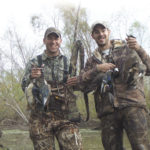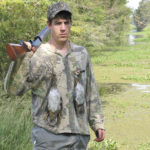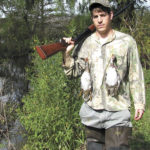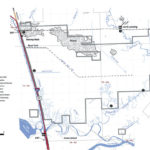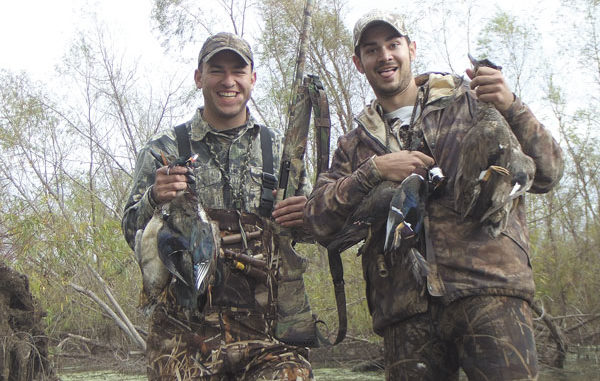
Joyce WMA beckons any waterfowl enthusiast who drives on I-55, and she conceals excellent action within her folds.
Face a firing squad, and you get a blindfold, right? Now I understood why.My doom seemed as imminent — and I was no more eager for a close-up of the grim reaper than a firing-squad victim. In fact, as things were going, a firing-squad would probably dispatch us more quickly and painlessly than the hideous doom Eddie seemed to have in store for us.
So I turned around in the boat seat to face the outboard and let my heavily jacketed back face the ripping north wind and the vision of the ghastly extinction that seemed certain.
Middle Bayou has more twists and turns than a nutrias intestinal tract, and Eddie was taking them at speeds to make an astronaut cringe. Even worse, the wind was whipping from the north at about 20 m.p.h., and since turning into Middle Bayou from North Pass, we’d been running straight into its teeth.
The windshield in Eddie’s custom-made skiff protected him, but Pelayo and I had sat face-forward as tears oozed from the corners of our eyes and vaporized against the blast of frigid wind as we blazed along. The 16-foot boat seemed airborne. With every turn I’d think we’d lose it, and I’d brace myself for the awful spin-out and terrifying collision against the wall of swamp maples and cypresses.
“Slow down!” Pelayo screeched at Eddie.
But Eddie was already slowing down on his own, and ramming the boat into a mass of wilted hyacinths along the bayou bank. Then he hit the switch. The outboard coughed to a halt, and its roar was immediately replaced by rattling palmettos and a whistling wind, as I slipped off my life vest. Gotta hand it to Eddie. He has (unwittingly) made a life-vest wearer out of me.
“It’s already getting light,” Pelayo rasped while jamming shells into his jump-suit pockets. “Let’s go. You know wood ducks.”
We knew wood ducks, alright. They fly the first 20 minutes after light, then vanish from the face of the earth. Another flight 10 minutes before dark, and that’s it.
“Might get more than woodies today,” Pelayo rasped. “With this weather, heck, a grey or mallard might just bumble over us.”
“I wouldn’t count on it,” Eddie snapped.
Middle Bayou was at most 10 yards wide here, but its surface was lashed into 3-inch hackles by the wind, and thick gray clouds seemed to scrape the stunted treetops as they scurried by.
We’d been hunting this area long enough to know the score, a few grays, mallards or widgeon might show up, but don’t count on it — unless the shooting has gotten hot and heavy a tad farther south at “the Prairie” in Manchac WMA and they’ve come up here where the hunting pressure is almost nil.
As so often happens nowadays with us, this hunt was as much an excursion to relive our high-school/college misadventures as to — just maybe — go home with the making of a gumbo. And when we first started hunting this area, there was no such thing as Joyce WMA. We’d launch at North Pass, scoot under the train bridge and down North Pass a bit, then head up Middle Bayou and start trudging, and trudging and trudging. Then we’d chunk out a few dekes on the the edge of some 10-foot-wide trenasse or old logging run (what passes for open water around here), huddle in some wax myrtles or palmettos and hope for a few shots at whistling woodies, maybe a teal or widgeon and usually a couple of hooded mergansers.
Pelayo slung the the sack of six teal decoys (they most resemble woodies) over his shoulder, but even without such encumbrances, it soon became evident that the years had taken a terrible toll on our marsh-trudging prowess. But on we pressed, trudging into the bowels (at least 300 yards) of a merciless quagmire known as Joyce WMA in the twilight gloom with a brutal cold front whipping the Spanish moss almost horizontal from its perch on the cypress limbs around us.
I could barely move in my overstuffed jumpsuit, but I knew in five minutes I’d be sweating. You’d need two hours in a pricey health-spa for the exertion equivalent of 10 minutes tromping through this trenasse-laced slop.
A hundred yards from the boat and still 200 yards from our hunt site, with sweat forming on my brow and my glasses fogging, I reflected on the name “Joyce.” Here’s a feminine name evoking images of something sweet and demure. For those who know her, however, Joyce is about as sweet and demure as Godzilla.
But she is a temptress. From a distance, she lures us like a siren. She bats her eyelashes at us as we drive over I-55 and gaze across her glades of myrtle and bull tongue. She winks with a sultry smile as we glide down Middle Bayou in spring casting spinnerbaits to the edge of her budding cypresses and red speckled maples. Gazing at her unadorned form in an aerial photo, our mouths water and pulses race at the thought of exploring her pristine folds.
But once in her arms, the romance vanishes. This thought hit me with a vengeance as I stumbled into a trenasse, plunging my hip-boot to within a half inch of flooding with icy slop and covering my hands, forearms and gun with putrid muck.
“Oh Joyce,” I groaned. “You evil wench! Why do I keep returning to your arms!”
The reason was right above me. That tell-tale woodie whistle jerked my head heavenward, where a pair of wood ducks was blazing overhead. Then I looked over at Pelayo pointing with a gloved hand at the treeline ahead where a dozen ducks, and these looked big (greys, maybe even mallards!), craned those long necks as they surveyed the swamp under them for a puddle to land in.
Mallards and grays are puddle ducks, right? Well, that’s exactly what Joyce offers: puddles. This place has no open water to speak of, and the mallards (in late, late season) and woodies think that’s just fine.
Finally we reached our puddle. It was 10 yards across at most and surrounded by marsh alders. Wading into it was asking for a dunking. I knew this from another, fortunately warmer, day, so I chunked out the decoys along the very edge, and we leaned against two young cypresses to break our outlines. Mine had a stump next to it, which made an ideal seat.
In this type of swamp terrain, with no open water, calling always helps. Alas, the predominant wood ducks aren’t known for their fervid — at least in our experience — response to calling. Nonetheless, Pelayo was emptying his lungs into his call. I looked over, and he pointed with his chin at the treeline some 200 yards distant. So he opened up with the hail call.
And in they came, but at the very perimeter of effective range, they started veering off. I guess they couldn’t see the decoys huddled near the shore. Now we both mouthed our calls while Eddie tooted on his widgeon whistle.
That did it. They locked up, and started a circle that took them behind us where they disappeared behind a stand of swamp maples. The suspense was unnerving. Did they land? Did they veer off again?
Ah! They’re still coming. We ducked instinctively as they circled out in front, set their wings against the wind and drifted in. What a sight! Their heads were swaying from side to side, and they even started quacking — I guess expecting an answer from their bogus brethren below. We had them.
Blam! Pelayo shot first, and folded a big grey on the left. The two remaining gadwall started flapping frantically with the wind in their wings when I finally emerged from my stupor and put the bead on the beak of one climbing to my right — Blam! — and he seemed to somersault in the air. But he didn’t fall. He was regaining his balance just as I shot again, and he folded in a puff of feathers.
When he hit the water, I noticed two others already there. I looked over at Eddie and Pelayo, and they were beaming.
Blam!
I was jolted from my daydream just in time to see a duck thudding to the winter-burnt grass on the edge of our puddle.
“Time to take up the slack with the woodies,” Pelayo said while walking to retrieve his woodie — a hen, not as pretty in a photo but plenty pretty in a gumbo.
In another half hour, we had another three woodies — then, as usual for them, the shooting shut down. No limits, but by our standards for this area, we’d had a fabulous hunt.
At a Ponchatoula convenience store, we noticed some kindred spirits huddled around a pick-up truck bed, arms resting on the tailgate, hands around a can, in the time-honored ‘apres hunt manner we all know so well.
“Y’all got ’em, huh!” Eddie whooped as he walked up.
A three-man limit of woodies lay in the truck bed.
“Nothing to it!” one of the hunters quipped. “Fifteen minutes after daylight, we all had limits.”
I was just coming out of the store when Pelayo came running up, seemingly flustered.
“Told ya. Told ya!” he huffed. “See those guys. Go see what they shot. Go ask ’em where they hunted!”
Pelayo’s agitation was fully warranted. He’d read about the recent addition to the WMA, and suggested we launch from Lee’s Landing and make a (relatively) easy swamp off the Tangipahoa River. Eddie and I scoffed.
Now here was proof that we’d blundered big time.
“Yeah, but they didn’t get near the exercise we got!” I blurted in lame defense.
Two days later, armed with new Joyce WMA maps, we launched at Lee’s Landing ourselves. After a short haul, we stopped at a distributary slough, trudged out a couple hundred yards (in this fairly firm area) lined up along a willow/cypress/tupelo treeline and, promptly at legal shooting time, started blasting. No limits, but we came out with seven, if with less exercise than during our previous “retro” hunt.
Since the mid 1980s, Joyce WMA has offered prime swamp for public hunting — but the place might as well have been on the moon. There it was, just sitting there — a short (under an hour) drive from New Orleans, its suburbs or Baton Rouge; barely a half hour from the Northshore.
But getting to its edge along Highway 51 on the west or by boat along North Pass on its south, or along the Tangipahoa River on its east wasn’t the half of it, wasn’t a quarter of it, wasn’t one-10th of it. After you made it to the rim, the interior might as well have been on the planet Pluto.
And it’s from that interior that the best hunting beckons.
Starting with the 2007 hunting seasons, this dilemma abated: 8,314 acres were added to the formerly 16,394-acre WMA. Best of all, this new acreage abuts both the Tangipahoa River and Bedico Creek, and both of these streams feature good launch sites a short boat ride north of the WMA boundary — the former at the end of South Highway 445 at Lee’s Landing, the other slightly east at the end of Traino Landing Road at, appropriately enough, Traino Landing itself.
No more treacherous chunk of swamp acreage exists in Louisiana. The place is a hideous amalgam of flotant swamp lying over old logging runs. You try walking the Maurepas Swamp WMA, and OK, it’s no picnic, but it’s doable. You pick your steps carefully from tree-base (especially cypress) to tree base, over large mats of alligator grass, and you can eventually make your way. You might sink 5 or 10 inches, maybe a foot in places, maybe more, but by being observant, you generally keep your chest waders — maybe even your hip boots — dry.
The same cannot be said for much of the Joyce WMA, especially what borders Highway 51. Bust through this, and you’re in serious trouble, especially in cold weather. Fortunately, the just added acreage does provide a semblance of good footing over pretty solid flotant areas, interspersed with more mature trees and ridges with more extensive root network and its attendant firmness.
The northern portion of Joyce is easily reached from South Slough, and it offers a picturesque mix of towering tupelos and a vast area of flotant-maidencane marsh marked as “The Prairie” on the map, but it’s strangely devoid of ducks. There’s no open water of any kind in this area, but — as almost everyplace around here — you’ll probably get pass shots at woodies at dawn.
More ominously, treated sewage is now being pumped into the area from a plant just north of the WMA border, which makes for an unpleasant outing in this area, regardless of any shots.
Waterfowl hunting closes at 2 p.m. on Joyce, so forget the dusk flight of woodies.
Area manager Chris Davis reports that last year, 216 waterfowl hunter efforts on Joyce yielded 181 ducks. But this is far from the total picture.
“These numbers are compiled from those hunters who left check-out data as reported from (mandatory) daily self-clearing permits,” he said. “Not all hunters check out, and some do not check in or out. So we undoubtedly had more hunters and more kill, but this should serve as a minimal number.”
Lee’s Landing has a box for these self-clearing permits, and we can all help the LDWF help us by filling them out — takes all of 20 seconds, for heaven’s sake!
